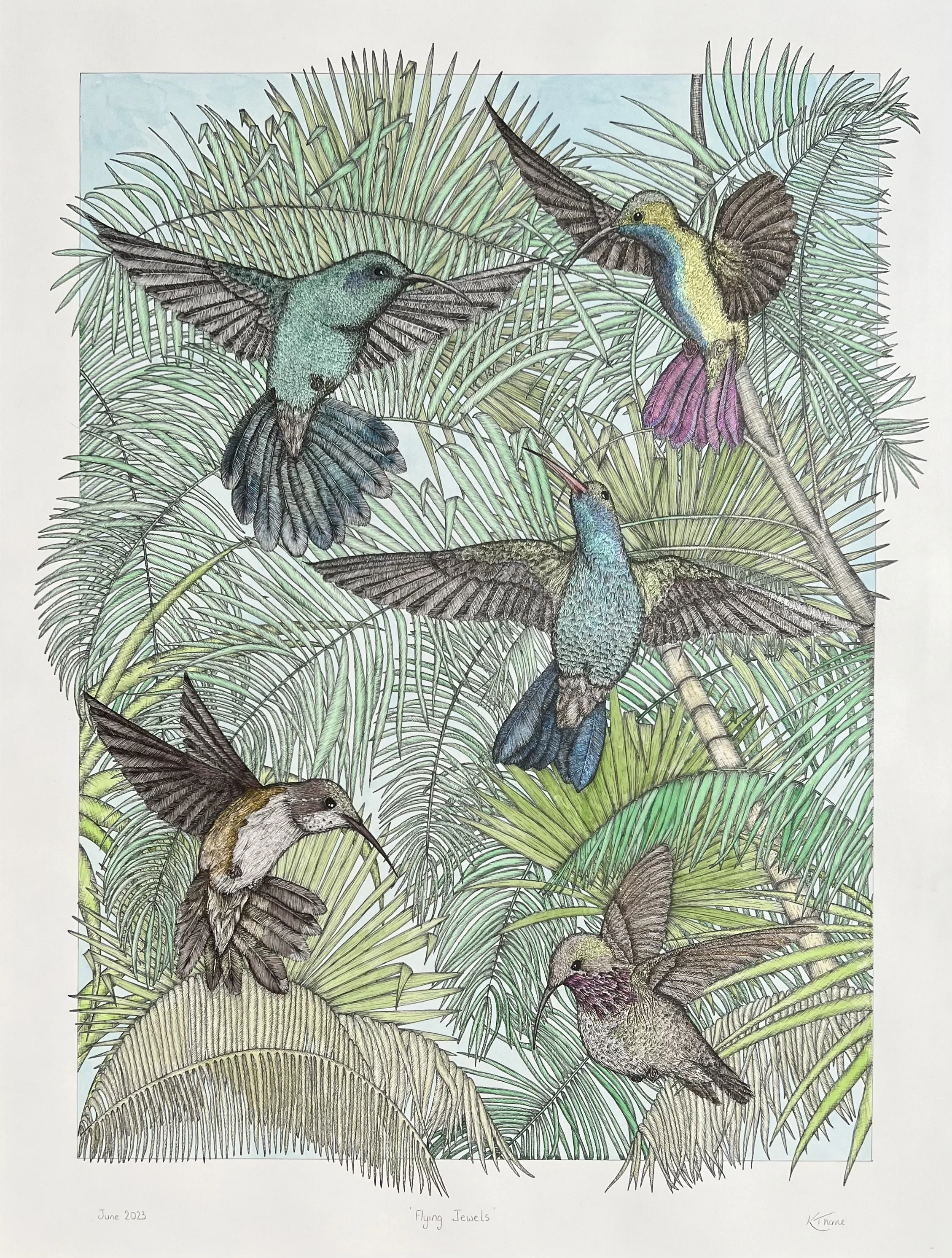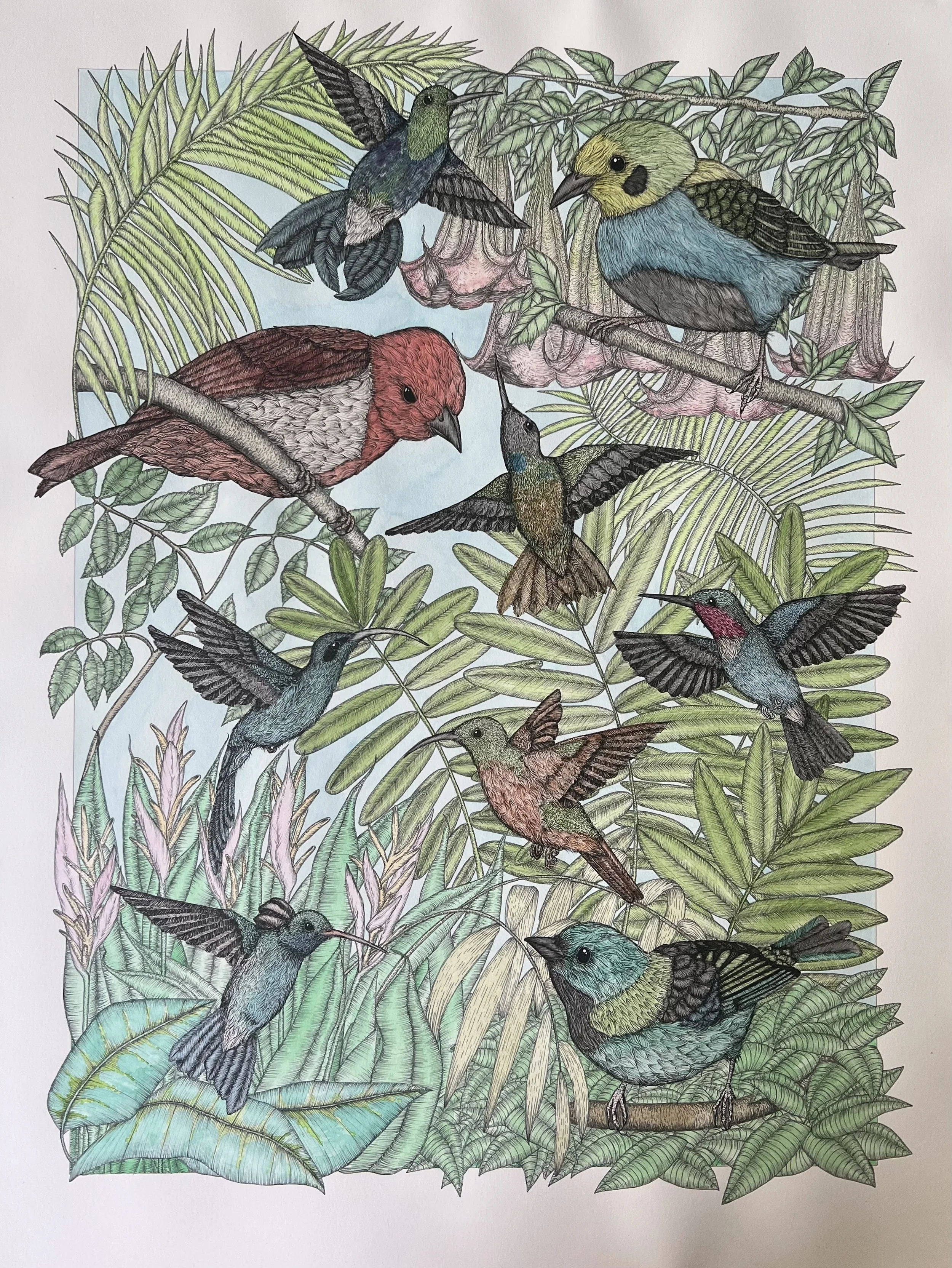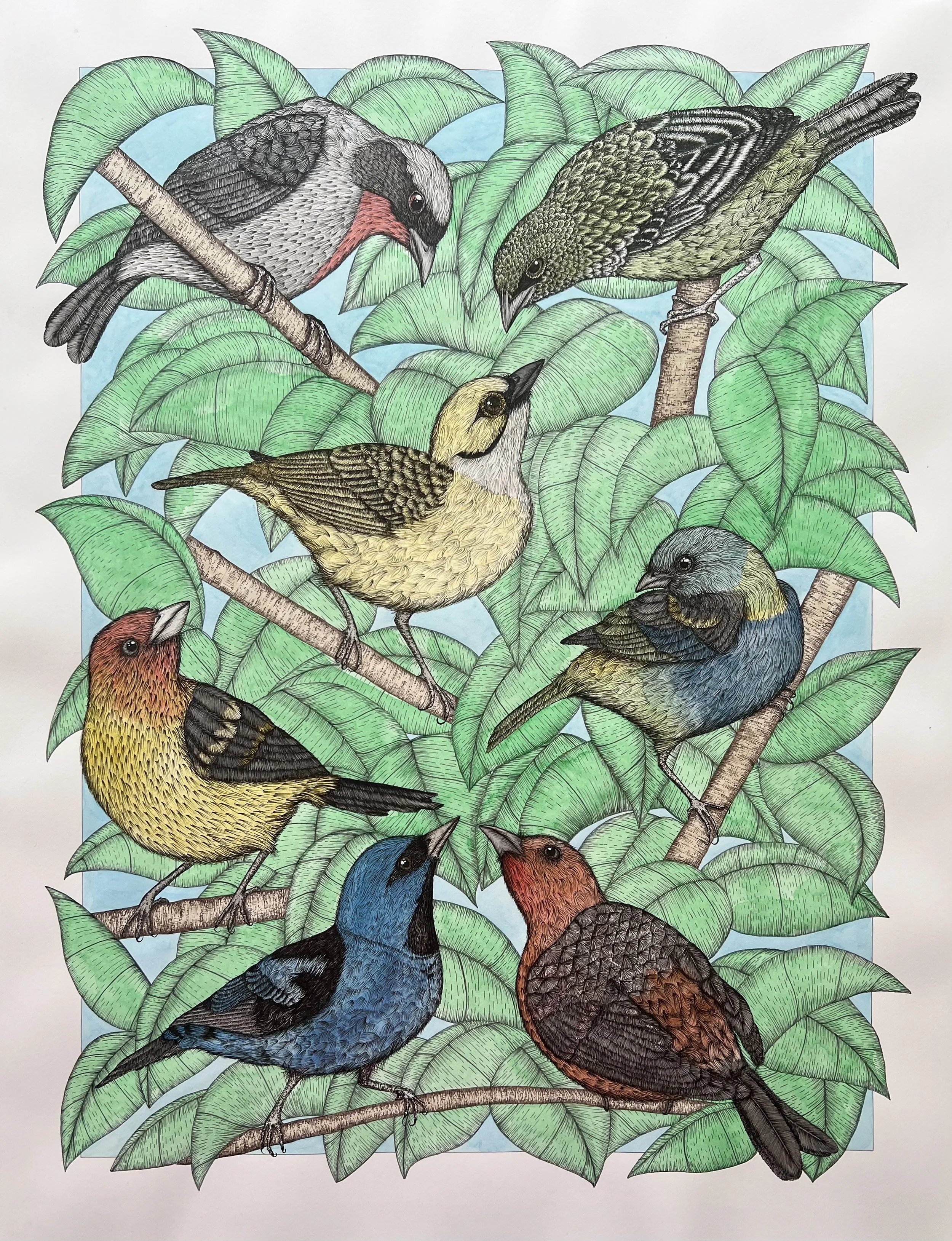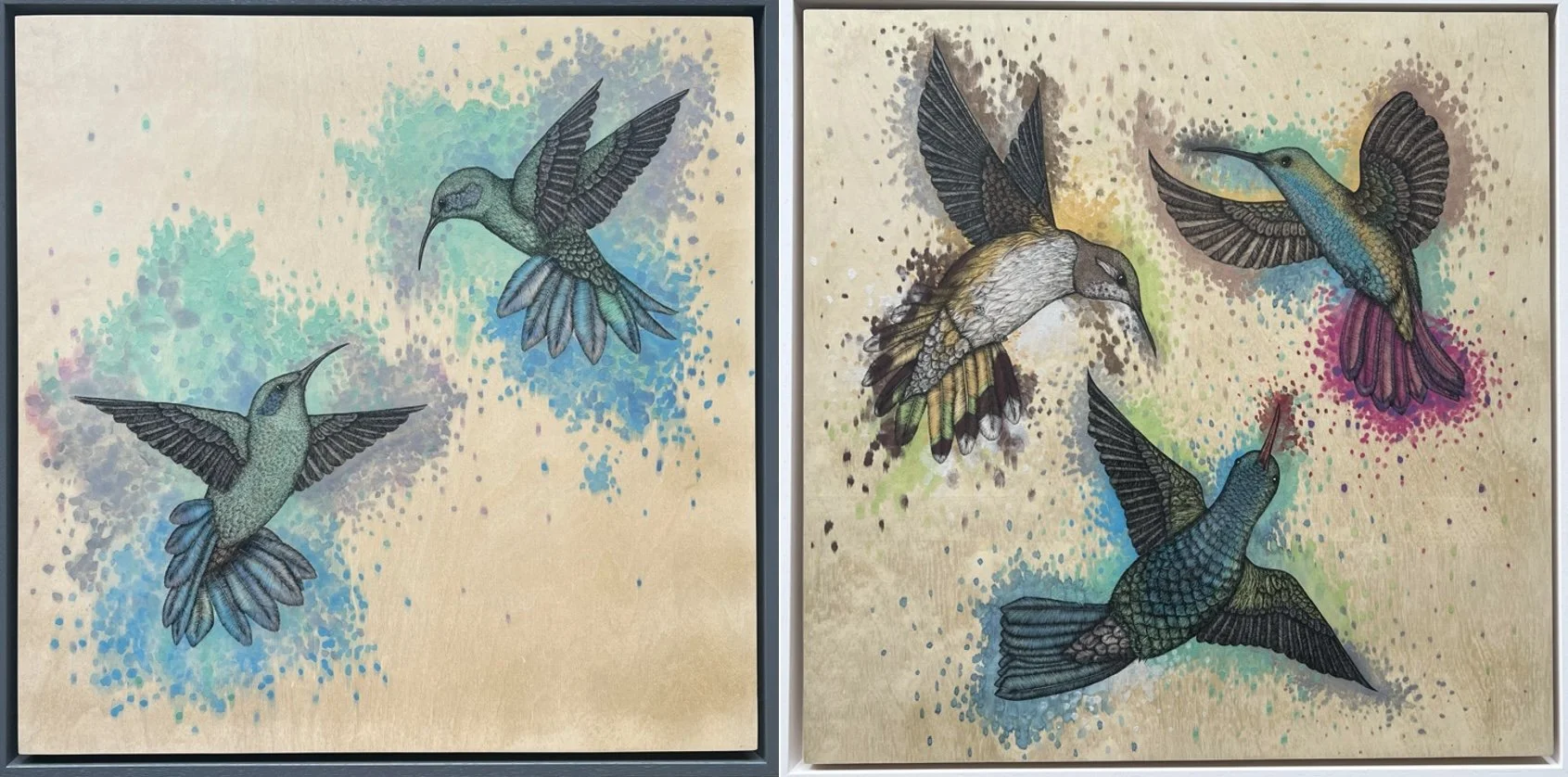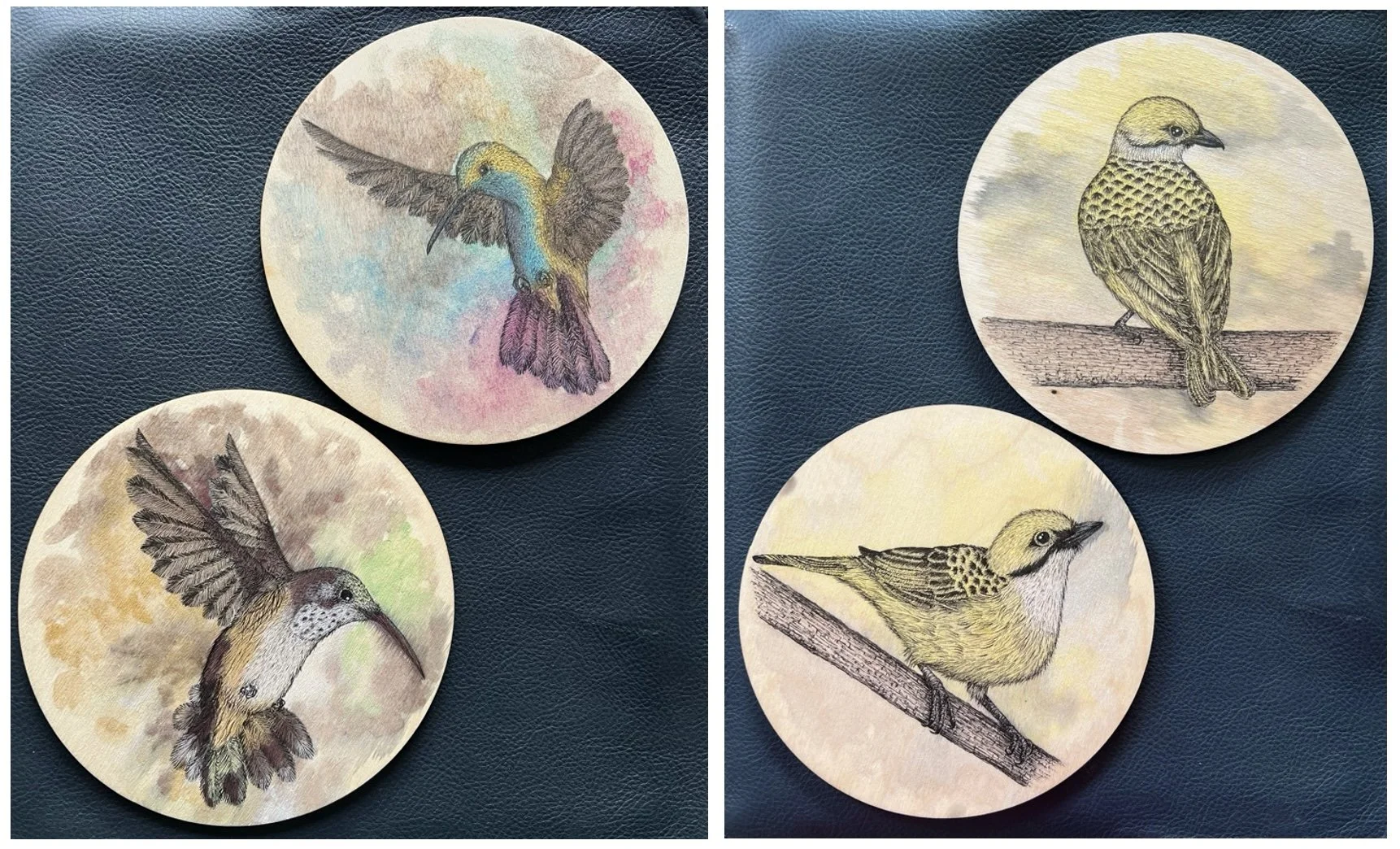The inspiration behind the Hummingbird and Tanager series
For April’s blog I thought I would chat about what I found, and continue to find interesting, intriguing and inspirational about Hummingbirds and Tanagers. I painted and drew them many times last year and this resulted in a series of work which I feel pretty proud of. This weekend I dropped the three biggies off at the framers where they will be displayed in a beautiful frame with non reflective glass ready for the Landmark Spring Fair in May. I cannot wait to collect them!
My interest in birds began a few years ago (cough, cough, 17 yrs!) when I was on safari in Tanzania and saw these little green, yellow and red birds sunbathing on the rocks. I remember thinking how beautiful they were with their wings and feathers on display, and I also never knew birds sunbathed! Fast forward to picking up a paintbrush and pen again, and one of the subjects I keep returning to is birds; whether its Flamingoes, Weaver Birds, an Ostrich, Peacock or Hummingbirds and Tanagers.
After a visit with my children last year I was inspired by the Hummingbirds in the display cabinet in The Natural History Museum (one of my favourite places to visit!). They have such character flitting between the branches.
In my piece; ‘Flying Jewels’ (left), I wanted to capture them in flight, like they were dancing in front of the leaves. In this piece I played with not only the movement of the birds but the leaves themselves.
I used metallic watercolours to represent their iridescent feathers which sparkles as the viewer moves in front of the piece and the light changes. Spanish explorers visited the America’s for the first time and saw these sparkling tiny birds. They were in awe of their vibrant colours and named them ‘flying jewels’. I think this is a perfect description and so I used this as the title of this piece.
I enjoyed creating ‘Flying Jewels’ so much I decided to work on another piece, this time adding Tanagers to the group. I wanted to the Tanagers to watch the Hummingbirds flying up out of the foliage. In this piece I varied the type of leaves and added flowers to soften and create layers of depth.
‘A Season and a Charm’ (right); a group of Hummingbirds is called a Charm and a group of Tanagers a Season’, still has a sense of movement and connection between the birds, and I loved becoming lost in the detail of the birds, foliage and flowers
Tanagers are so colourful and always look like they have so much to say that I thought they deserved to be the focus of their own piece of art! For ‘Season of Brilliance’ (left) I wanted the Tanagers to interact with each other almost like they were having a conversation. I kept the leaves and branches in the background uniform in shape and colour so the focus was on the Tanagers and their interactions.
Although each of these large pieces have a running theme and similar quality to them they are each individual pieces with different intentions. I developed these ideas further when working on wooden panel boards for ‘The Dance’ and ‘Flying Together’ (below). With these pieces the focus is purely on the birds, their movement, and their interactions with each other.
‘The Dance’. ‘Flying Together’
Hummingbirds and Tanagers are beautiful birds to observe but also to know about…..
Hummingbird Facts
1. They are the smallest migrating bird. They don’t migrate in flocks like other species, and they typically travel alone for up to 500 miles at a time.
2. The name, hummingbird, comes from the humming noise their wings make as they beat so fast.
3. Hummingbirds are the only birds that can fly backwards.
4. Hummingbirds have no sense of smell. While they can’t sniff out feeders, they do have good colour vision.
5. Their tiny legs are only used for perching and moving sideways while perched. They can’t walk or hop.
6. Hummingbirds drink the nectar found in feeders by moving their tongue in and out about 13 times per second. They can consume up to double their body weight in a day.
7. The average number of eggs laid by female hummingbirds is only two. These eggs compare in size to a jellybean or a coffee bean. Some species, like the Black-chinned Hummingbird make their nests with plant down, spider silk, and other natural resources that can expand as their babies grow after hatching.
8. There are over 330 species of hummingbirds in North and South America.
‘Black-Throated Mango Hummingbird’. ‘Silver Throated Tanagers’
‘Allen’s Female Hummingbird’
Tanager Facts
1. Tanagers are 239 species of extremely colorful, perching birds that make up the family Thraupidae.
2. Tanagers are birds of forests, forest edges, and shrublands.
3. Species of tanagers occur from temperate southern Alaska and Canada south to Braziland northern Argentina
4. Tanagers are small birds, ranging in body length from 3-12 in (8-30 cm), and are generally smaller than 8 in (20 cm). Their body shape is not particularly distinctive, but their brilliant colors are.
5. In most species, the female has a more subdued coloration than the male.
6. Tanagers defend a territory during the breeding season. An important element of their defense is song, and some species are accomplished vocalists.
7. The female builds a cup-shaped or domed nest. She also incubates the one to five eggs.
8. The female tanager is fed by the male during her egg-incubating seclusion. Both parents tend and feed their young.
I hope after reading this month’s blog you see why I find Hummingbirds and tanagers, and birds generally, so fascinating. I am planning on creating some new work exploring further my Endangered Species pieces, but I have no doubt birds will feature somewhere in this new body of work and I will continue to feel the pull to create more work based on them in future.
